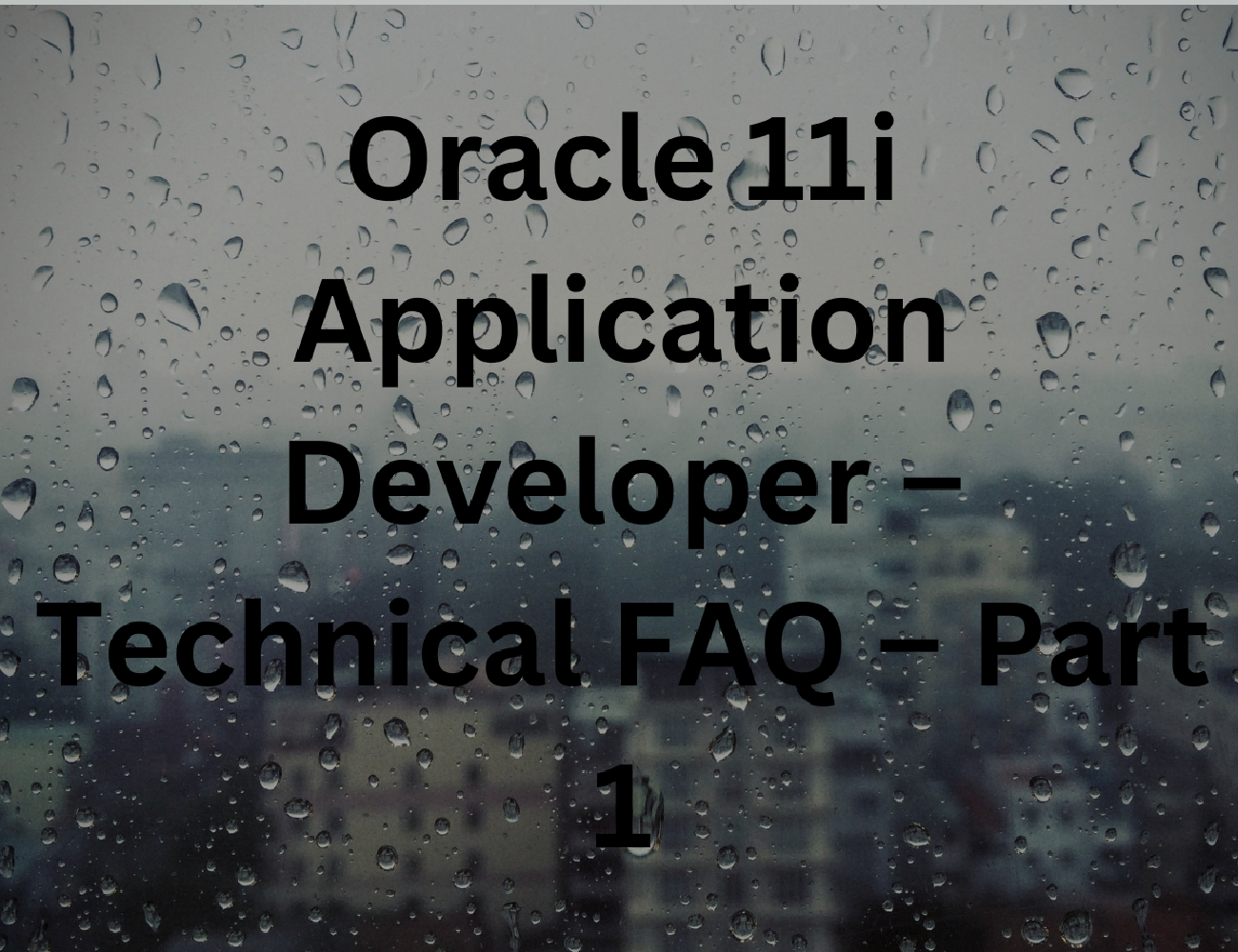Oracle 11i Application Developer – Technical FAQ – Part 1

Hello Friends, Some of my friends are requesting to put some good easy and relevant Questions along with Answers for Oracle Application which are used in all modules. So here i am putting some question in parts, each part having 10 Questions. plz share your feedback on difficulty level and your interest.
this is now updated and corrected after feedback from gerath.
Q1 In which FND table independent value set will be stored?
A 1 FND_FLEX_VALUES and FND_FLEX_VALUES_TL
Q2 How to schedule the concurrent programs from Back end(PLSQL) -not from SRS form.
A2 fnd.request.submit_request( Concurrent_program_name, application_short_name, description, parameters)
Use FND_REQUEST.SUBMIT_REQUEST
Example: req_id := FND_REQUEST.SUBMIT_REQUEST(‘FND’, ‘FNDSCARU’); Fnd_request.submit_request can be called from any valid EBS session (initialized by fnd_global.apps_initialize)
Q3 Where do concurrent request log files and output files go?
A3 The concurrent manager first looks for the environment variable $APPLCSF, If this is set, it creates a path using two other environment variables:
$APPLLOG and $APPLOUT
It places log files in $APPLCSF/$APPLLOG
Output files go in $APPLCSF/$APPLOUT
So for example, if you have this environment set:
$APPLCSF = /u01/appl/common
$APPLLOG = log
$APPLOUT = out
The concurrent manager will place log files in /u01/appl/common/log, and output files in /u01/appl/common/out
Note that $APPLCSF must be a full, absolute path, and the other two are directory names. If $APPLCSF is not set, it places the files under the product top of the application associated with the request. So for example, a PO report would go under $PO_TOP/$APPLLOG and $PO_TOP/$APPLOUT
Logfiles go to: /u01/appl/po/9.0/log
Output files to: /u01/appl/po/9.0/out
Of course, all these directories must exist and have the correct permissions. Note that all concurrent requests produce a log file, but not necessarily an output file
Q4 How do I cancel a running concurrent request?
A4 Navigate to the Concurrent Request Summary form
Select a request
In GUI, use the Cancel buttons
The Sysadmin responsibility can cancel any running request , If you cancel a running request be aware that the backend process continues. See this good forum discussion for details: http://forums.oracle.com/forums/thread.jspa?threadID=832725&tstart=0
Q5 Why does Help->Tools->Examine ask for a password?
A5 The profile option Utilities:Diagnostics is set to NO
This profile option controls whether users can use the Examine utility. The password should be the APPS password.
Q6 How do I check if Multi-org is installed?
A6 SELECT multi_org_flag FROM fnd_product_groups;
Q7 How do I find the name of a form?
A7 GUI: Use Help->About Oracle Applications
Scroll down to find the form name
Q8 How do I open a form in query-only mode?
A8 Navigate to the Form Functions form (Application->Function) Query the particular form and add the parameter QUERY_ONLY=YES
go to applcation developer responsibility
navigation->Application/function.
query the function name
then goto form tab
then goto parameters field
then write the following code QUERY_YES=”YES”
save the changes and then see the forms get affected in query only mode.
Q9 How can I change in custom.pll? After changes how can I send on the server and what’s effect in this condition?
A9 1. FTP the Custom.pll from $AU_TOP/resource
2. Open the Custom.pll in 11i or earlier
3. Include the following code for your Form logic :
begin
Form_Name varchar2(50) := name_in(‘system.current_form’);
If Form_Name = ‘YOUR CUSTOM FORM” then
begin
include your logic
end;
end;
4. Once changes over , using the following command to generate the CUSTOM.plx
f60gen module=CUSTOM.pll userid=apps/apps@mfgdev module_type=LIBRARY
to generate the latest CUSTOM.plx and move this CUSTOM.plx to $AU_TOP/resource
Q10 What is ‘$flex$ and ‘$profile$, What is the use of ‘$flex$’
A10 $Flex$ is used when we need to return the Flex value contained by any AOL Vlauset or AOL object . they used within Forms, value sets.
For Ex . $Flex$.<Valueset name> would return the value held by that valueset .
$profiles$. are used to get the values of environment variables like org_id or mfg_Organization_id etc which are related to the current apps environment.
Ex. $profiles$.org_id would return the operating unit which is active at that time for the user
Will be updating with more question in upcoming posts.
Shivmohan Purohit
